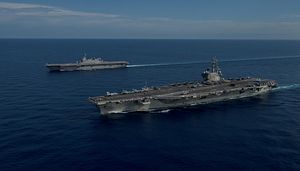Can the United States Navy get to 355 ships without a profound shift in the global strategic situation? Does it need to do so in order to keep China in its box? Steve Wills offers some reasons for skepticism, reasons that can apply equally to China and the United States.
Wills argues both that democracies face specific problems with peacetime naval buildups, and that the buildups often yield less of strategic value than they promise. Technology develops in unexpected ways, the strategic situation does not work out in the way that policymakers had predicated, and democratic governments are saddled with flotillas of ships that cost money to maintain but no longer serve a compelling strategic purpose. Wills points to successive modernizations of the Royal Navy in the 19th century, but also to the 1980s era buildup in the United States, the last major expansion that resulted in a hybrid fleet that kept older ships in service longer than economical, and sent some modern ships to the scrapyard before their time.
Motivation is a problem for peacetime naval buildups, especially in democracies. In the case of the United Stdates, while the strategic class has determined that the People’s Liberation Army Navy (PLAN) represents a core threat to U.S. interests, the commercial class and the population at large have yet to come to the same conclusion. Generally speaking, almost no one outside of military and strategic circles in the United States thinks about the relationship between the United States and China as zero-sum. U.S. and Chinese companies continue to invest in one another; U.S. students study in China and vice versa. Even the Trump administration, which has described trade relations in zero-sum terms, has in practice treated negotiations with China as a game in which both countries can benefit.
The idea that China might expand its reach into the South China Sea remains quite more abstract than the idea that the Soviet Navy might break trans-Atlantic logistical routes, or that the High Seas Fleet represented a core threat to Britain’s maritime security. Advocates of a naval buildup need to make clear how the mere existence of China’s navy poses a threat to the United States. They need to develop a better argument as to why Americans need to invest considerable treasure in an effort to maintain the U.S. margin of advantage in a sea lanes directly off China’s coast.
That said, China also faces dangers with respect to the rapid buildup of its naval forces. China’s naval buildup in the past 15 years in in some ways akin to the great peacetime naval expansions of the Soviet Union, Wilhelmine Germany, the United Kingdom, and the United States. As Wills suggests, the development of massive armaments programs in peacetime often results in obsolescent military equipment. The Soviet Union and Italy faced this problem in the 1940s, and even the vast dreadnought fleet built by the United Kingdom in the first two decades of the 20th century was mostly obsolete by 1920. And of course China is making a huge investment in aircraft carriers, a capability that many argue the other weapons that China has developed (including most notably advanced cruise and ballistic missile systems) will render obsolete.
The course of technological innovation is not entirely beyond the control of states, but it is difficult to predict. That said, contemporary naval architects are more cognizant of the problems of technological change than their counterparts from the dawn of the 20th century. Most modern naval vessels are built with open architecture in mind, so that they can take advantage of advances in technology that their builders do not yet fully perceive. Moreover, modern navies are fortunate in that the large, flat-decked aircraft carrying ship is flexible enough to operate in a bewildering variety of different strategic and technological contexts, even if its capabilities are limited in specific situations.
In the contemporary context, the drive to maintain the size of the fleet has resulted in the Littoral Combat Ship, the Zumwalt-class destroyer, and the Arleigh Burke Flight III destroyer, all of which represent significant compromises. The U.S. Navy needs to think very carefully about how the future frigate will fit into the fleets of 2030, 2040, and 2050, and how past decisions may hamstring future force structure.

































